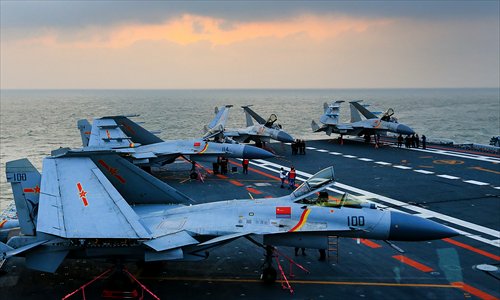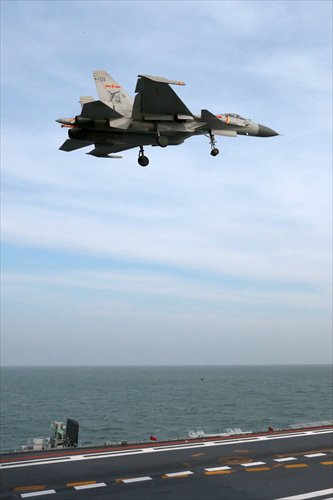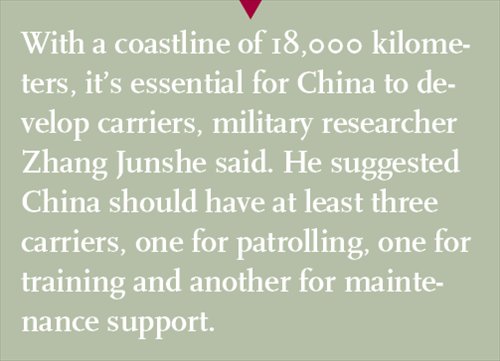Chinese public eagerly awaits commissioning of second aircraft carrier
Chinese public eagerly anticipate building of second aircraft carrier
Controversy shrouds China's first domestically made aircraft carrier, which is rumored to be launched later this year. Chinese experts argue that the country requires new hardware to respond to possible security issues from the Taiwan question and territorial disputes, as well as enhancing national prestige and demonstrating China's international responsibility, while a former US governmental official downplayed the possibility of major tensions, telling the Global Times that the US is retiring from its role as global policeman. But still, the US, owner of 11 carriers, is reluctant to lose this role.

J-15 fighter planes sit on the deck of the Liaoning aircraft carrier during training exercises in the Bohai Sea on December 24, 2015. Photo: CFP
Zhang Enkuan, a military enthusiast, was thrilled to hear the news that China's first self-made aircraft carrier will likely be tested on the open sea later this year.
"It's the pride of the nation. To maintain our maritime rights, we must have aircraft carriers," the 44-year-old agriculture expert from Xinyang, Central China's Henan Province, told the Global Times. "We need them to protect our sovereignty in the South China Sea and on the Diaoyu Islands."
In August 2011, when China's first aircraft carrier, which was bought from Ukraine and refitted, set sail from Dalian, Liaoning Province, on its maiden voyage, he started a donation campaign on Weibo to help pay for future aircraft carriers.
He set up a QQ group to raise money, which quickly attracted more than 100 netizens from various walks of life, including students and migrant workers, Zhang said. But at last, as the military authorities refused to accept any donation, he disbanded the group.
But he opened a Weibo account named "Maintain Chinese Maritime Rights," and has kept updating it with related news, gaining more than 2,700 followers.
Zhang is one of millions of Chinese who are happy about the new aircraft carrier. An earlier online survey conducted by huanqiu.com, the Chinese-language website of the Global Times, showed that out of more than 9,000 respondents, 93 percent yearn for domestically made aircraft carriers. In addition, nearly 48 percent of them think China should build three to six carriers, and 46 percent think the country should build up to nine.

A J-15 fighter plane flies over the Liaoning aircraft carrier during training exercises in the Bohai Sea on December 24, 2015. Photo: CFP
Defensive strategy
Recently, military fans uploaded a group of pictures of China's second carrier which is being built in Dalian. The photos show that the major parts of the ship including its hangar, bow and stern have been installed.
"According to the pictures posted by military fans, the ship is near completion and will likely be tested in the water this year," Lan Yun, deputy editor-in-chief of the Beijing-based Modern Ships magazine, told the Global Times.
In an interview with the Global Times last week, the Ministry of National Defense (MOD) declined to disclose the schedule, saying the carrier is under construction and the next step will be determined according to construction progress.
The MOD first confirmed that it was building the country's second carrier at a press conference on December 31 last year. The conventionally powered craft, with a full-load displacement of 50,000 tons, will carry J-15s (a multi-purpose carrier-borne fighter jet) among other aircraft, said MOD's spokesman Yang Yujun.
"The design and construction have absorbed experience from scientific research, tests and training on the Liaoning aircraft carrier, and we will make lots of improvements and upgrades," Yang said.
The two Chinese carriers with their ski-jump-style launch ramps lag behind the West's nuclear-powered ones with launching catapults, which are capable of operating for over 20 years without refueling and launching much heavier aircraft.
In addition to the second aircraft carrier, the deployment of high-end missiles and submarines, and China's military buildup in general has been regarded by many in the West as a "growing threat." In February, Kelley Sayler, Defense Strategies and Assessments Program Associate Fellow with the Center for a New American Security, issued a report, "Red Alert: The Growing Threat to US Aircraft Carriers," warning that Chinese missiles may threaten US aircraft carriers in future conflicts in the Asia-Pacific.
Last week China Central Television (CCTV) reported the test launch of 400 kilometer-range YJ-62 anti-ship cruise missiles. It was widely speculated the launches were carried out on Yongxing Island in the South China Sea, a region in which several other countries make territorial claims.
The MOD tried to lessen such worries. "China develops aircraft carriers to safeguard national security, as well as to help maintain world peace and stability," the ministry spokesman reiterated in the interview with the Global Times. "Chinese defensive national defense policy and its military strategy of active defense are clear-cut and will not change because of development of advanced weapons."
The Liaoning has made dozens of scientific research, tests and training trips since it officially entered service in 2012.

Dream of generations
Zhang Xusan, former vice admiral of the PLA Navy, told the Xinhua News Agency that building an aircraft carrier is a dream shared by several generations of Chinese people.
"Any country that wants to become a world power can't do it without construction and application of aircraft carriers," Zhang was quoted as saying.
Chinese dreams of having an aircraft carrier dates back to 1928, when the commander of China's navy Chen Shaokuan proposed the construction of an aircraft carrier to the Kuomintang government, 10 years after the world's first aircraft carrier was launched in San Francisco.
The founders of the People's Republic of China also expressed regret about not having an aircraft carrier. In 1973 during a meeting with foreign visitors, then Chinese premier Zhou Enlai lamented that "our Nansha and Xisha islands were occupied by South Vietnam. Without an aircraft carrier, we can't let our navy to fight just with bayonets."
"Having an aircraft carrier is a standard for a powerful country. It's a symbol of a country's comprehensive ability, military ability, especially naval ability," said Zhang Junshe, a researcher from PLA Naval Military Studies Research Institute.
Only when its overall power, economic power and technology reach a certain level can a country build an aircraft carrier, which in turn will strengthen military defense and promote military modernization, he noted.
Besides, with a coastline of 18,000 kilometers, it's essential for China to develop carriers, Zhang said. He suggested China should have at least three carriers, one for patrolling, one for training and another for maintenance support.
Yin Zhuo, a senior researcher with the PLA Navy Equipment Research Center, told China National Radio in March that China needs to build up its maritime power to safeguard its national interests both offshore and in the open seas, citing the fact that 60 percent of China's petroleum imports travel via the Indian Ocean and South China Sea.
"By 2030, China will possibly become the largest creditor, and overseas Chinese workers will number in the millions. Safeguarding the security of Chinese people and overseas assets will become the task for the navy, including the aircraft carrier fleets," Yin was quoted as saying.
Regional contest
Lan Yun said currently eight countries have aircraft carriers, including the US, the UK, France and Italy. "But the US has more than all the other countries combined," Lan said.
The US has 11 nuclear-fueled carriers whose full-load displacements are nearly double the Chinese ones. As some are approaching the end of their operational life, the country is building upgraded replacements. According to naval-technology.com, the USS Gerald R Ford and USS John F Kennedy, will be commissioned in 2016 and 2020 respectively.
However, some US officials are not happy about the Chinese military buildup.
Wallace "Chip" Gregson, former assistant secretary of defense for Asian and Pacific security affairs, has said "Chinese military buildup far exceeds China's defensive needs." He popularized the term "anti-access/area denial" (A2/AD), which has been widely used to describe the Chinese "military threat" posed by the nation developing missiles and other advanced weapons.
Zhang Junshe said the term is "provocative."
"The term is forced on us. We haven't got such a strategy," Zhang told the Global Times. "Their counter-A2/AD purpose is to conduct military interference in Asian-Pacific region," he added, citing the war that may take place if China uses its military to prevent Taiwan from declaring independence.
He said China needs to shore up its military muscle to deter powers which intend to use force to undermine State sovereignty and interfere in domestic affairs.
"As long as we have a strong defensive and fighting capabilities, we have the ability to strike back and take revenge," Zhang said.
Ralph Benko, a former official in the Reagan administration who now works as a senior advisor for the American Principles Project think tank, said that mistrust between Washington and Beijing has contributed to tensions.
"As China strengthens and becomes the dominant influence in its neighborhood it is natural it will wish to shoulder the appropriate military burden associated with that. It's inevitable. It makes a minor but vocal faction of our elite nervous," Benko told the Global Times via e-mail.
Under the domestic cry of "Make Money, Not War!" the US is retiring from its role as world police as world peace is dawning, Benko claimed, although its military-industrial complex doesn't favor America returning to a peacetime footing and smaller military.
Apparently, the US doesn't want to abandon this role soon. A total of 10 Ford-class carriers are planned with construction continuing to 2058, according to a report posted on naval-technology.com.
Pragmatic approach
Cao Weidong, a military expert, told CCTV that after the aircraft carrier is in the water, the power plant and deck superstructure will be installed. Following a series of tests, the carrier will be officially commissioned.
But some military fans are disappointed that the Chinese aircraft carrier is still much weaker than the US's.
The Pentagon's Defense Intelligence Agency also downplayed the capabilities of the aircraft carriers China is building.
According to a blog titled "China's aircraft carriers: the-ultimate paper tiger?" posted last month on the website of National Interest, an American bi-monthly international affairs magazine, US Marine Corps. Lt. Gen. Vincent Stewart, director of the Defense Intelligence Agency, said Chinese carriers "will not have the same blue open ocean capability that our aircraft carriers have."
Lan Yun said the significance of China's second aircraft carrier lies in the fact that it is a milestone. "Unlike other countries which can purchase advanced technology or equipments from the well-developed countries, China built it all from zero," Lan said, noting that the Western countries have been implementing a technology blockade against China, especially on military technology.
"Due to immature research and technology, the self-made aircraft adopting ski-jump and conventional power is a pragmatic approach. What's more, I believe our aircraft is designated to respond to neighborhood threats, not compete with the US's," Zhang Enkuan said.
Newspaper headline: Naval necessity